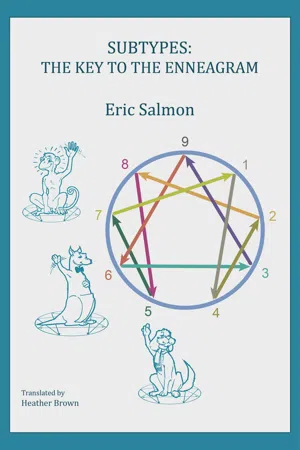![]()
PART 1: DISCOVERING THE IMPORTANCE OF SUBTYPES
In order to understand the origins and principles of the Enneagram subtypes, it is important to take account of some key strands of personality theory and psychology which influenced the development of Enneagram and subtype theory. This chapter therefore starts with an outline of the psychological movements that impacted on the development of the Enneagram in the 20th century. These movements in psychology led to the development of a theory about how the tiny child builds its defence mechanisms in order to survive life – and this forms the basis of the three centres and the nine Enneagram types. This sets the context for the description of the subtypes which then follows, and helps to make clear why and how the subtypes are the manifestation of our type in everyday life. Noticing, understanding and having compassion for our subtype behaviour is the foundation for our personal development.
The Development of the Enneagram in the 20th Century
1960 – San Francisco Bay
“Psycho–analysis is essentially the result of observing mental activity/life; that’s the reason why the understanding of its structure remains incomplete and subject to constant modification.” Freud didn’t know how right he was – psychoanalysis was only a stage on the journey. Even before the 2nd World War many researchers were digging in different directions in their explorations of the human soul. Most European researchers decided that, given the political context, they were better off moving to the USA to continue their research. Once they got there they stayed, and mixed with their opposite numbers on the other side of the Atlantic. Some of them would revolutionise the study of humanity: Abraham Maslow, Gregory Bateson, Fritz Perls, Carl Rogers, Wilhem Reich, Ludwig Binswanger and others… Their discoveries about human functioning influenced not only the world of psychology but also other sciences such as quantum physics. Later, the Vietnam War played an important role – it caused most of these researchers to move to the American west coast, as did most pacifists. The result was that during the 1960s there was, to the south of San Francisco, the greatest concentration of “psychology researchers” – psychiatrists, psychologists and philosophers – in human history. Several movements developed, of which the three main ones were humanistic psychology, the Palo Alto school and transpersonal psychology. The researchers of these different schools were starting to revolutionise the way the way we understand other people. A revolution was under way, a pressing need to understand human nature better and to rediscover the essence of Being. It started to become clear that a self-awareness tool was needed; the Enneagram emerged and was successful because of this fertile ground. The three key post-war pioneers of the Enneagram, Oscar Ichazo, Claudio Naranjo and Helen Palmer, saw the Enneagram first and foremost as a way of expanding consciousness.
Humanistic psychology
This discipline brings together luminaries such as Carl Rogers, Rollo May and Erich Fromm. Founded in 1963, the Association of Humanistic Psychology has 5 key tenets (1): that individuals
are more than the sum of their parts
are affected by their relationships with others
are conscious
have choice
and are endowed with free will.
The Palo Alto School (2)
This school was founded on the basis of Gregory Bateson’s research on systemic thought. The fruit of this research was a new way of thinking, which could be summarised as “Think globally, act locally”.
“Think globally” – what does this mean? In the West, we have always taught our children analytical thought processes, i.e. that in order to understand a phenomenon, we need to break it down into its constituent parts. Systemic thinking, on the contrary, holds that each element can only be understood by referring to the global context of which it is part.
“Act locally” – this consists in taking practical action at the point where prompt action can lead to the greatest change.
Over thirty years, systemic thinking has been transposed with great success into sectors as complex as unemployment, the environment or understanding violence. From a psychological point of view, this way of thinking has three key applications: family therapy, brief therapy and Gestalt. The five principles of the Association of Humanistic Psychology apply equally well to this school.
Transpersonal psychology
The transpersonal movement was set up in the USA in 1969 around a statement of C. G. Jung that the intellect is just a small part of the psyche, whereas the psyche itself has a cosmic dimension. For Jung, every soul needs transcendence; the individual needs to connect with the sacred. Jung was the first of the psychologists who didn’t stop at intellectual and emotional functioning but went beyond the personal to the transpersonal(3); that is, believing that as humans we are essentially searching for a higher part of ourselves. This Swiss trail-blazer was followed by several humanists such as Abraham Maslow, Viktor Frankl, Charles Tart(4) and Stanislas Grof. They went beyond “classic psychology”; they plumbed the depths of human consciousness, taking further the work of Karlfried Graf Duerckheim and Rudolf Steiner. Without actually being spiritual, this movement was interested in the higher aspects of Being.
Conscious Humanity
It was in this context that the Enneagram would really get going, in San Francisco in 1971. Not only did all the research results on the psyche come together, but they started to result in practical applications. For example, all these researchers, and other therapists too, validated the relevance of Gestalt therapy(5) when they went on courses with Friz Perls at the Esalen Institute, one of the first centres for personal development. In this melting pot of new perspectives, the really revolutionary contributi...
